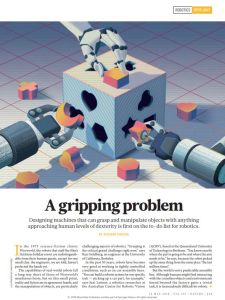Join getAbstract to access the summary!

Join getAbstract to access the summary!
Richard Hodson
A Gripping Problem
Humans are masters of dexterity. But robots are catching up.
Nature, 2018
What's inside?
As robots take over myriad industrial tasks, researchers struggle to teach them how to grip and grasp.
Recommendation
Robots contribute precise, efficient work to many industries, and their use continues to expand, fueled by new technology. Today’s robots build and pack products with amazing efficiency, but their ability to grasp and manipulate objects remains limited. Researchers address these critical challenges through repetitive machine learning, advanced software and soft, human-like hand designs. Those curious about both the possibilities and limitations of today’s industrial robots will be engaged by this overview of new developments.
Summary
About the Author
Richard Hodson writes for Nature Outlook supplements. He gained an MA in science journalism from City University London, and studied biomedical science at King’s College London.
















Comment on this summary